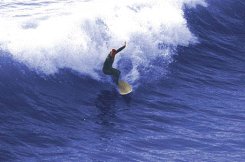
March 1999
Physical Conditioning for Better Surfing
Bruce Gabrielson
March 1999
Introduction
For some reason, conditioning for surfing seems to be a hot topic. I'm continually asked what I recommend to stay in shape in the off-season, or to get into serious competition shape. To keep my emails shorter, I decided to write this down and also request that anyone who uses other techniques feel free to send them to me. I plan to update this paper before long and will welcome any suggestions. Although I was usually in tremendous shape because of the workouts I was doing as a championship level wrestler, much of this conditioning could be considered cross training. I will state that I don't think I ever did get into as good of shape as Dale Dobson, he was a machine.
The information below is part of what I recently sent a competitive surfer in Australia. I'm sure there are other approaches besides what I used.
 To understand what conditioning it takes to compete in surfing, you really
need
to understand what the unique things surfing demands of your body. Simply
put,
you need to be flexible and have rhythm to surf well. Overbuilding muscles
might
lead to reduced flexibility, and this condition would definitely be a
disadvantage.
To understand what conditioning it takes to compete in surfing, you really
need
to understand what the unique things surfing demands of your body. Simply
put,
you need to be flexible and have rhythm to surf well. Overbuilding muscles
might
lead to reduced flexibility, and this condition would definitely be a
disadvantage.
As best as I can remember, here is what my friends and I did to stay in shape in the off season or to get us into serious competition shape. Again I point out that I was simultaneously involved in an extensive conditioning program for another sport, so many of the techniques listed were cross training activities.
Jump Roping
Besides lots of time in the water, I spent time running and jump roping - not much weight training. Running builds endurance. Jump roping builds both endurance and quick responses. You absolutely need very quick responses if you are going to be able to react to the quick changing conditions of a high performance wave. Jump roping didn't really catch on with world class athletes in all sports until Olympian Buddy Lee came along. He developed a series of drills that have now been incorporated into the majority of Olympic team training programs for all sports.
Roller Skates
Roller-skating was another of my "special" training activities. I don't mean using a skateboard, which I also did, but I've found that roller-skating (or even roller blading) will develop balance faster than anything will I know of. Get yourself a pair of roller blades and use them on a regular basis. If you can't afford blades, go workout at a roller rink once a week. Serious outdoor roller blading can also take the place of running to build up your conditioning.
Skateboarding for Power
Racing on a skateboard is similar to a giant slalom in skiing, and will help the power aspect of a surfer's individual style. Longer and heavier type skateboards, just like surfboards, are best suited for this type of training. The idea is to shift your balance over longer flowing turns rather than short, jerky movements. By adding speed, you can learn to adjust your balance evenly when you turn. I had a large hill where I practiced on a regular basis when the surf was blown or small.
Weight-Room Exercises.
Probably the best weight room type exercise I found was a rowing machine. Like many other earlier era surfers I had plenty of back problems. However, once I started rowing, my lower back pain disappeared, plus my paddle strength increased drastically. It seams that rowing may also help conditioning as I was usually winded after a 2-mile quick paddle. During college, I had the chance to surf with a member of my school's rowing team. He wasn't that big physically but was a super fast paddler, even through heavy surf.
If your back does start to bother you, there is one exercise that you absolutely must try. It worked for me, plus has worked for some more recent professional surfers that I told about it. Find a gym where you can hang from your knees, head down. Take a light weight, maybe 5-10 lbs, hold it behind your head, then arch back up and down for three sets. This started to cure my chronic back problems in only a few weeks.
There was another exercise that I used occasionally. I found that the curl exercise on the weight machine built my grip, something I needed to paddle through waves. This helped especially before we used leashes, and also in Hawaii where you just couldn't let go of your board.
Link to an email I sent to a researcher on training
Link to an email I sent to a reporter about surfing for older folks.